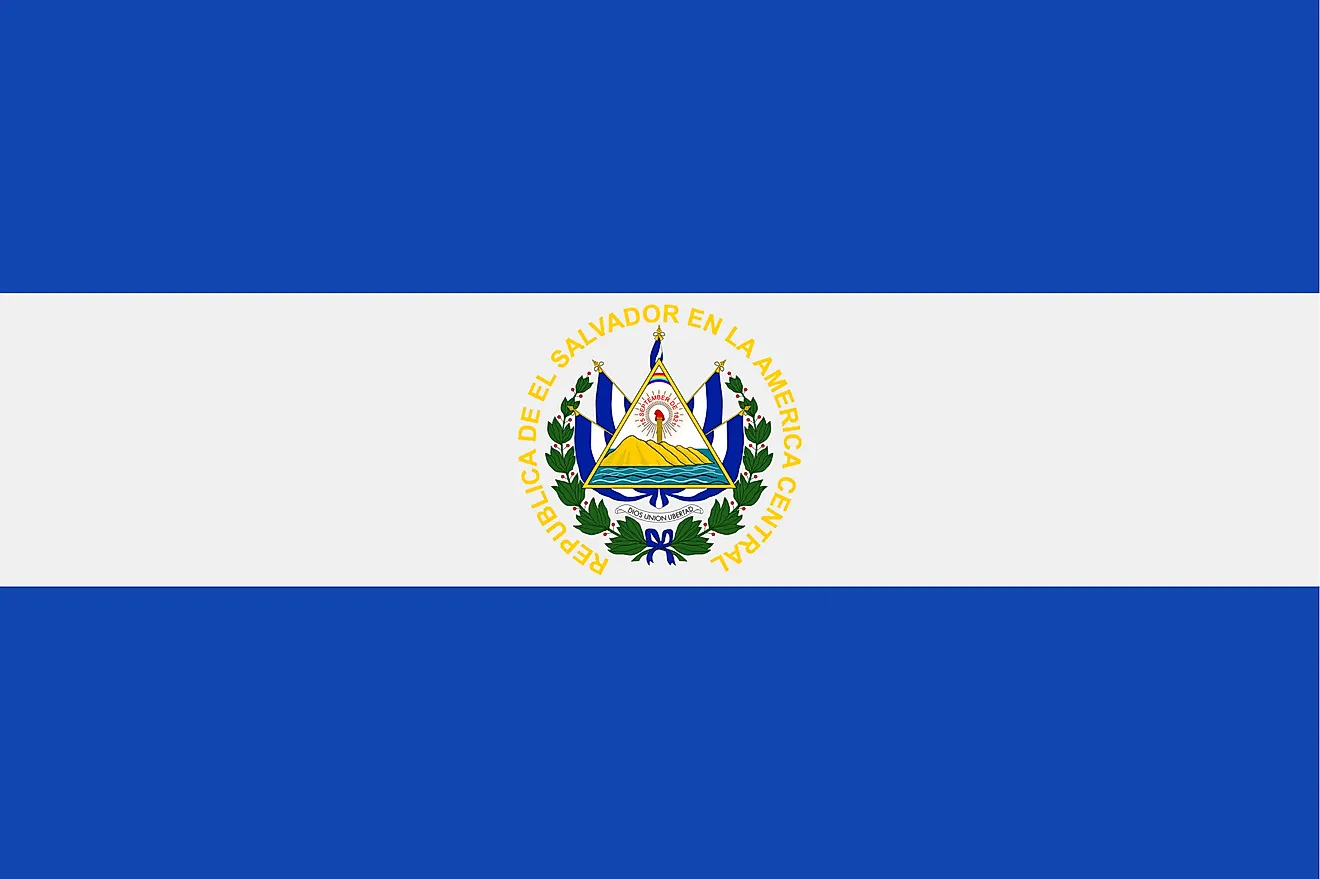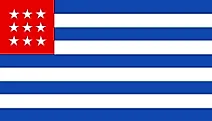What Is the Blue and White Flag on El Salvadors Flag Mean
Flags, Symbols & Currency of El Salvador

The National Flag of El Salvador was officially adopted on May 17, 1912.
The National Flag of El Salvador features three equal horizontal bands of cobalt blue (top), white, and cobalt blue with the national coat of arms centered in the white band. The Coat of Arms features a round emblem encircled by the words REPUBLICA DE EL SALVADOR EN LA AMERICA CENTRAL. The cobalt blue band color symbolizes the sky as well as the Caribbean Sea and the Pacific Oceans. The white band color represents the land between the two bodies of water, as well as peace and prosperity. The flag has a width-to-length proportion ratio of 189:335 or 4:7.
History of the Flag of El Salvador
Being under the control of the Spanish Empire, the first flag that was flown in El Salvador in 1535, was a burgundy cross of the Viceroy of New Spain. When Mexico occupied the area in 1821, the flag of the First Mexican Empire was adopted. This flag featured the green-white-red vertical tricolor along with the Mexican Coat of Arms placed in the center. The First Mexican Empire was replaced by The Federal Republic of Central America in 1823. This flag was a blue-white-blue flag along with the Republican coat of arms placed at the center. This flag was replaced in 1839, with a flag that had 9 alternating blue-white stripes with a red box along with 9 white stars placed in the upper left corner. In 1875, more 5 stars were added to the flag. In 1896, the Greater Republic of Central America was created when El Salvador joined with Nicaragua and Honduras. Their flag featured a dark blue-white-dark blue horizontal tricolor, with the coat of arms placed in the center of the flag. This flag was replaced by the modern current flag of El Salvador in 1912.
Symbols of El Salvador
The National Coat of Arms of El Salvador
The current official National Coat of Arms of El Salvador was adopted on September 15, 1912. The center of the Coat of Arms consists of a yellow-bordered triangle, in which five green volcanoes rise out of the blue ocean. These five volcanoes symbolize the five member states of the United Provinces of Central America. Above the volcanoes is a red Phrygian cap on staff before a golden sun and the date 15 September 1821 (the Independence Day of El Salvador). A rainbow is placed above. Behind the coat of arms, there are five raised flags representing the flags of the Federal Republic of Central America. Under the flags, there is a scroll which states the national motto of El Salvador: Dios, Unión, Libertad which means "God, Union, Liberty". All of this is surrounded by a laurel garland, which is tied together under the national flag. The garland is divided into 14 different parts, which symbolize the 14 Departments - the Salvadoran subnational administrative units. The Coat of Arms is encircled by the words: REPUBLICA DE EL SALVADOR EN LA AMERICA CENTRAL.
National Motto
"Dios, Unión, Libertad" ("God, Union, Liberty")
National Anthem
- Anthem Title: "Himno Nacional de El Salvador" ("National Anthem of El Salvador")
- Music Composer: Juan Aberle
- Lyricist: General Juan José Cañas
- Date of Adoption: December 11, 1953
"Himno Nacional de El Salvador" ("National Anthem of El Salvador") is the national anthem of El Savador. The music of the anthem have been composed by Juan Aberle. The lyrics of the anthem have been authored by General Juan José Cañas. The anthem was first sung on September 15, 1879 and was officially adopted on December 11, 1953. Only the chorus and the first verse of the full anthem is generally sung.
"Himno Nacional de El Salvador" (Spanish)
CORO:
𝄆 Saludemos la patria orgullosos
de hijos suyos podernos llamar
y juremos la vida animosos,
sin descanso a su bien consagrar. 𝄇
𝄆 Consagrar, consagrar. 𝄇
PRIMERA ESTROFA
De la paz en la dicha suprema,
Siempre noble soñó El Salvador;
Fue obtenerla su eterno problema,
Conservarla es su gloria mayor.
Y con fe inquebrantable el camino
Del progreso se afana en seguir
Por llenar su grandioso destino,
Conquistarse un feliz porvenir.
Le protege una férrea barrera
Contra el choque de ruin deslealtad,
Desde el día que en su alta bandera
Con su sangre escribió: ¡LIBERTAD!
𝄆 Escribió: ¡LIBERTAD! 𝄇
CORO
SEGUNDA ESTROFA
Libertad es su dogma, es su guía
Que mil veces logró defender;
Y otras tantas, de audaz tiranía
Rechazar el odioso poder.
Dolorosa y sangrienta es su historia,
Pero excelsa y brillante a la vez;
Manantial de legítima gloria,
Gran lección de espartana altivez.
No desmaya en su innata bravura,
En cada hombre hay un héroe inmortal
Que sabrá mantenerse a la altura
De su antiguo valor proverbial.
𝄆 Valor proverbial. 𝄇
CORO
TERCERA ESTROFA
Todos son abnegados, y fieles
Al prestigio del bélico ardor
Con que siempre segaron laureles
De la patria salvando el honor.
Respetar los derechos extraños
Y apoyarse en la recta razón
Es para ella, sin torpes amaños
Su invariable, más firme ambición.
Y en seguir esta línea se aferra
Dedicando su esfuerzo tenaz,
En hacer cruda guerra a la guerra:
Su ventura se encuentra en la paz.
𝄆 Se encuentra en la paz. 𝄇
CORO
"National Anthem of El Salvador"
CHORUS:
𝄆 Let us salute the Fatherland,
Proud to be called its children,
And let us spiritedly swear our lives
To consecrate its good without rest! 𝄇
𝄆 Consecrate, consecrate! 𝄇
FIRST VERSE
Of the peace in the supreme happiness
Ever noble El Salvador dreamed
To achieve this has been Her eternal proposition,
To keep it, Her greatest glory.
And with unwavering faith, the path of progress
She strives to follow, to follow
To fulfil Her greatest destiny
And conquer a happy future.
A stern barrier protects Her
Against the clash of vile disloyalty,
Ever since the day when Her soaring Flag,
Wrote "LIBERTY!" with Its blood.
𝄆 Wrote: LIBERTY! 𝄇
CHORUS
SECOND VERSE
Freedom is Her dogma and Her guide;
A thousand times She has managed to defend it,
And as many times She repelled
The hateful power of atrocious tyranny.
bloody and sad her story is,
Yet at the same time sublime and brilliant,
A source of legitimate glory
And a great lesson in spartan pride.
Her innate bravery does not waver:
In every man there is an immortal hero
Who will know how to keep himself up to
The proverbial value of old.
𝄆 Proverbial value. 𝄇
CHORUS
THIRD VERSE
All are devoted and faithful
To the tradition of warlike bravery
With which they have always reaped fame
By saving the Motherland's honour.
To respect the rights of others
And base Her actions on right and justice
Is for Her, without infamous trickery,
The constant and most firm ambition.
And in following this line She persists,
Dedicating her tenacious efforts
In waging hard war to war;
Her fortune is found in peace.
𝄆 Is found in peace. 𝄇
CHORUS
The Currency of El Salvador is the United States dollar
The current official currency of El Salvador is the United States dollar (USD, $). The country adopted the US dollar as its currency in 2001. The US dollars are issued by the Federal Reserve. One US dollar can be divided into smaller units of 100 called cents or 1,000 mills.
Coins:
The first definition of the US dollar occurred through the Coinage Act of 1792. The popular dollar coins used are 1 cent, 5 cents, 10 cents, and 25 cents.
Banknotes:
The common banknotes include 1, 5, 10-, 20-, 50-, and 100-dollar bills. However, the 2-dollar bill is becoming rare.
Historical currencies of El Salvador
After obtaining independence from Spain in 1830, El Salvador informally used macaco as its currency, before it became the country's official currency in 1856. During this time, other currencies such as the Spanish peso and brass coins were also used for executing transactions. The first time El Salvador minted its currency was in 1877. The minted currency was in form of silver coins and paper currency. Later on, following the implementation of the First Monetary Law in 1883, the peso was adopted as El Salvador's currency replacing the macaco. At first, 1 peso was equal to 8 reals. However, with time 1 peso became equal to 10 reals. The government gave three banks the right to issue the currency; Agricola Commercial, Banco International, and Occidental Salvadoreño. In 1892, the Monetary Law was revised resulting in the official currency being changed from peso to El Salvadoran Colon. The word "colon" was derived from the name of Christopher Columbus as, in Spanish, his name was translated to "Cristobal Colon." One colon was equal to 100 centavos, and its exchange rate at the time was 2 colons per 1 dollar. The sole issuer of the colon became the Central Reserve Bank of El Salvador in 1934. The reserve bank minted its first bills on August 31, 1934. The colon was the currency of El Salvador from 1892 to 2001, before the country adopted the use of the US dollar. The dollar was adopted following the end of the civil war that negatively impacted the economy. It was a stable currency and the government of El Salvador hoped that it would boost their economy.
Source: https://www.worldatlas.com/flags/el-salvador

0 Response to "What Is the Blue and White Flag on El Salvadors Flag Mean"
Postar um comentário